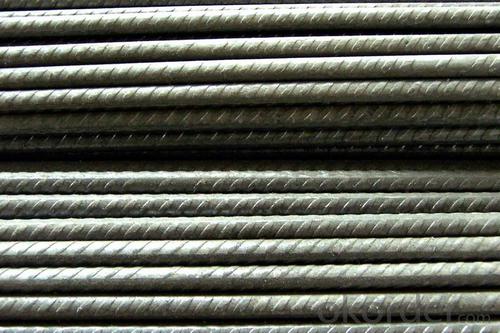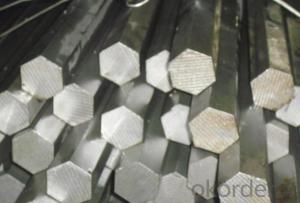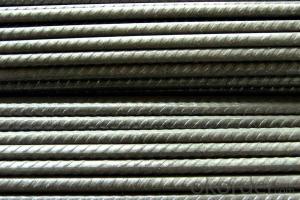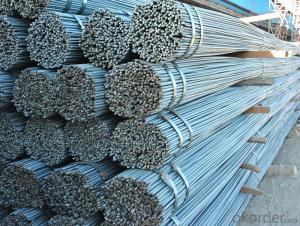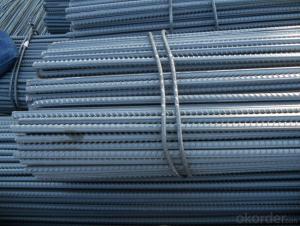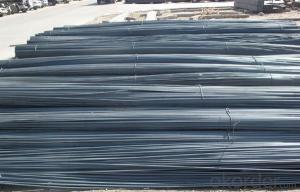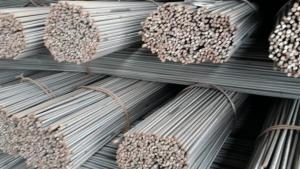High quality deformed barhot rolled 10-50mm
- Loading Port:
- Tianjin
- Payment Terms:
- TT OR LC
- Min Order Qty:
- 25 m.t.
- Supply Capability:
- 100000 m.t./month
OKorder Service Pledge
OKorder Financial Service
You Might Also Like
Deformed Bar Details:
| Minimum Order Quantity: | Unit: | m.t. | Loading Port: | ||
| Supply Ability: | Payment Terms: | Package: | wire rod packing |
Product Description:
Product Description:
Specifications of HRB400 Deformed Steel Bar:
Standard | GB | HRB400 | |
Diameter | 6mm,8mm,10mm,12mm,14mm,16mm,18mm,20mm, 22mm,25mm,28mm,32mm,36mm,40mm,50mm | ||
Length | 6M, 9M,12M or as required | ||
Place of origin | Hebei, China mainland | ||
Advantages | exact size, regular package, chemical and mechanical properties are stable. | ||
Type | Hot rolled deformed steel bar | ||
Brand name | DRAGON | ||
Chemical Composition: (Please kindly find our chemistry of our material based on HRB500 as below for your information)
Grade | Technical data of the original chemical composition (%) | ||||||
C | Mn | Si | S | P | V | ||
HRB400 | ≤0.25 | ≤1.60 | ≤0.80 | ≤0.045 | ≤0.045 | 0.04-0.12 | |
Physical capability | |||||||
Yield Strength (N/cm²) | Tensile Strength (N/cm²) | Elongation (%) | |||||
≥400 | ≥570 | ≥14 | |||||
Theoretical weight and section area of each diameter as below for your information:
Diameter(mm) | Section area (mm²) | Mass(kg/m) | Weight of 12m bar(kg) |
6 | 28.27 | 0.222 | 2.664 |
8 | 50.27 | 0.395 | 4.74 |
10 | 78.54 | 0.617 | 7.404 |
12 | 113.1 | 0.888 | 10.656 |
14 | 153.9 | 1.21 | 14.52 |
16 | 201.1 | 1.58 | 18.96 |
18 | 254.5 | 2.00 | 24 |
20 | 314.2 | 2.47 | 29.64 |
22 | 380.1 | 2.98 | 35.76 |
25 | 490.9 | 3.85 | 46.2 |
28 | 615.8 | 4.83 | 57.96 |
32 | 804.2 | 6.31 | 75.72 |
36 | 1018 | 7.99 | 98.88 |
40 | 1257 | 9.87 | 118.44 |
50 | 1964 | 15.42 | 185.04 |
Usage and Applications of HRB400 Deformed Steel Bar:
Deformed bar is widely used in buildings, bridges, roads and other engineering construction. Big to highways, railways, bridges, culverts, tunnels, public facilities such as flood control, dam, small to housing construction, beam, column, wall and the foundation of the plate, deformed bar is an integral structure material. With the development of world economy and the vigorous development of infrastructure construction, real estate, the demand for deformed bar will be larger and larger..
Packaging & Delivery of HRB400 Deformed Steel Bar:
Packaging Detail: products are packed in bundle and then shipped by container or bulk vessel, deformed bar is usually naked strapping delivery, when storing, please pay attention to moisture proof. The performance of rust will produce adverse effect.
Each bundle weight: 2-3MT, or as required
Payment term: TT or L/C
Delivery Detail: within 45 days after received advanced payment or LC.
Label: to be specified by customer, generally, each bundle has 1-2 labels
Trade terms: FOB, CFR, CIF
- Q: Are steel rebars easy to handle and install on-site?
- Yes, steel rebars are generally easy to handle and install on-site. They are commonly used in construction projects for reinforcing concrete structures, such as buildings, bridges, and roads. Steel rebars are available in various sizes and lengths, making them versatile and easy to work with. They can be easily cut, bent, and shaped to fit the required specifications and design of the structure. Additionally, steel rebars are lightweight compared to other materials used for reinforcement, making them easier to transport and maneuver on-site. They also have excellent tensile strength, which ensures structural stability and durability. However, it is important to note that proper safety precautions should be taken when handling and installing steel rebars, as they can be sharp and pose a risk of injury if not handled correctly.
- Q: Can steel rebars be used in residential swimming pool construction?
- Residential swimming pool construction can indeed benefit from the incorporation of steel rebars. These rebars are frequently employed to fortify concrete structures, such as swimming pools. By reinforcing the concrete, the rebars enhance its strength and durability, enabling it to endure the water's pressure and weight. The utilization of steel rebars also serves to avert cracks and structural harm that may occur over time. Additionally, these rebars are readily accessible, cost-effective, and can be conveniently installed by professional pool builders. In conclusion, it is highly advisable to include steel rebars in the construction of residential swimming pools to ensure a dependable and long-lasting pool structure.
- Q: How do steel rebars contribute to the seismic performance of concrete buildings?
- Steel rebars contribute to the seismic performance of concrete buildings by providing reinforcement and strength to the structure. The rebars help to distribute and dissipate the energy generated during an earthquake, increasing the building's ability to withstand the seismic forces. They enhance the concrete's tensile strength, preventing cracking and enhancing its overall durability. The combination of concrete and steel rebars creates a composite material that can absorb and withstand the lateral forces caused by ground shaking, reducing the risk of structural failure during seismic events.
- Q: Can steel rebars be used in structures with high radiation shielding requirements?
- Yes, steel rebars can be used in structures with high radiation shielding requirements. Steel has good radiation shielding properties and is commonly used in such structures to provide protection against radiation.
- Q: How do steel rebars affect the constructability of projects in environmentally sensitive areas?
- Steel rebars can have a significant impact on the constructability of projects in environmentally sensitive areas. Their use can present challenges in terms of excavation and foundation work, as well as potential disturbance to delicate ecosystems. Additionally, the production and transportation of steel rebars can contribute to carbon emissions and other environmental concerns. Therefore, alternative construction materials or techniques may need to be considered to minimize the environmental impact and ensure sustainable development in these areas.
- Q: How do steel rebars affect the overall aesthetics of a building?
- Steel rebars typically do not affect the overall aesthetics of a building as they are usually hidden within the concrete structures. However, their presence is crucial for reinforcing the building's strength and durability, ensuring the structural integrity and safety of the construction.
- Q: How do steel rebars impact the overall constructability and scheduling of concrete projects?
- The constructability and scheduling of concrete projects are greatly influenced by the presence of steel rebars. These reinforcing bars are essential for providing strength and stability to concrete structures, ensuring their durability and resilience. To begin with, the inclusion of steel rebars within the concrete significantly improves the overall structural integrity of the project, enhancing its constructability. By reinforcing and supporting the concrete, the rebars enable the construction of taller and more complex structures. They help distribute the load and withstand tension and compression forces, making the project more reliable. Furthermore, the presence of steel rebars facilitates the scheduling of concrete projects. When properly planned and incorporated, the rebars can expedite construction timelines. By integrating the rebars into the concrete formwork, construction teams can efficiently pour and shape the concrete, reducing the curing time required to achieve the desired strength. This directly affects project scheduling, enabling faster construction progress and potential cost savings. In addition, the utilization of steel rebars in concrete projects allows for flexibility in design and construction. The ability to customize the placement, size, and spacing of rebars ensures that the concrete structure meets specific design requirements and intended functionality. This flexibility becomes particularly crucial in projects that involve intricate architectural features or require specific load-bearing capacities. However, it is important to acknowledge that the proper installation and coordination of steel rebars can present challenges in terms of scheduling. To avoid delays, rebar installation must be carefully coordinated with other construction activities. Moreover, quality control measures are essential to ensure the accurate placement and alignment of rebars, as any errors or deficiencies can significantly impact the overall quality and safety of the project. In conclusion, steel rebars have a significant impact on the constructability and scheduling of concrete projects. They enhance the strength and stability of concrete structures, allowing for the construction of more intricate and robust designs. Additionally, the proper incorporation of rebars can expedite construction timelines and provide flexibility in project scheduling. However, careful planning, coordination, and quality control are necessary to ensure the successful integration of rebars in concrete projects.
- Q: How do steel rebars contribute to the durability of concrete?
- Steel rebars contribute to the durability of concrete in several ways. Firstly, they provide reinforcement to the concrete structure, increasing its overall strength. The steel rebars act as a skeleton within the concrete, helping to distribute the load and resist the forces that act upon the structure. This reinforcement prevents cracking and enhances the structural integrity of the concrete. Secondly, steel rebars help to control the cracking of concrete. Concrete is prone to crack due to various factors such as shrinkage, temperature changes, and external loads. By incorporating steel rebars, the concrete is able to withstand these forces and prevent the cracks from spreading. This ensures that the concrete remains intact and durable over time. Furthermore, steel rebars contribute to the durability of concrete by increasing its resistance to corrosion. Concrete is porous, and if exposed to moisture, it can lead to the corrosion of embedded steel. However, the presence of steel rebars, which are typically coated with materials that provide corrosion resistance, helps to protect against this issue. This extends the lifespan of the concrete structure and ensures its long-term durability. In summary, steel rebars play a crucial role in enhancing the durability of concrete by providing reinforcement, controlling cracking, and preventing corrosion. Their presence strengthens the overall structure, improves its resistance to external forces, and ensures the longevity of the concrete.
- Q: Can steel rebars be used in offshore oil and gas platform construction?
- Yes, steel rebars can be used in offshore oil and gas platform construction. They are commonly used to reinforce concrete structures in these platforms, providing strength and durability to withstand the harsh marine environment.
- Q: What are the common defects observed in steel rebars?
- Some common defects observed in steel rebars include: 1. Rust and corrosion: Steel rebars are susceptible to rust and corrosion when exposed to moisture and oxygen. This can weaken the structural integrity of the rebar and compromise the overall strength of the concrete structure. 2. Cracks and fractures: Rebars can develop cracks and fractures due to various factors such as excessive bending, improper handling during transportation and installation, or overloading. These defects can reduce the load-bearing capacity of the rebar and affect the performance of the concrete structure. 3. Lack of bond: Adequate bond between the rebar and the surrounding concrete is crucial for transferring loads effectively. However, poor surface preparation, improper placement, or the presence of contaminants can lead to a lack of bond, resulting in reduced structural strength. 4. Bent or deformed rebars: Rebars are often bent during fabrication to fit specific construction requirements. However, improper bending techniques, excessive bending, or mishandling can result in rebars with incorrect shapes or deformities. These defects can compromise the structural integrity and load-bearing capacity of the rebar. 5. Dimensional inaccuracies: Steel rebars must conform to specific dimensional tolerances to ensure proper fit and alignment within the concrete structure. However, manufacturing errors or improper storage and handling can lead to dimensional inaccuracies, causing difficulties during installation and potentially affecting the structural performance. 6. Inclusions and impurities: Steel rebars should ideally be free from any inclusions or impurities that can weaken the material. However, inadequate quality control during the manufacturing process can result in the presence of foreign materials or impurities within the steel, which can reduce its strength and durability. It is important to ensure proper quality control measures and adherence to industry standards during the manufacturing, transportation, and installation of steel rebars to minimize these defects and ensure the long-term structural integrity of concrete structures.
Send your message to us
High quality deformed barhot rolled 10-50mm
- Loading Port:
- Tianjin
- Payment Terms:
- TT OR LC
- Min Order Qty:
- 25 m.t.
- Supply Capability:
- 100000 m.t./month
OKorder Service Pledge
OKorder Financial Service
Similar products
Hot products
Hot Searches
Related keywords



